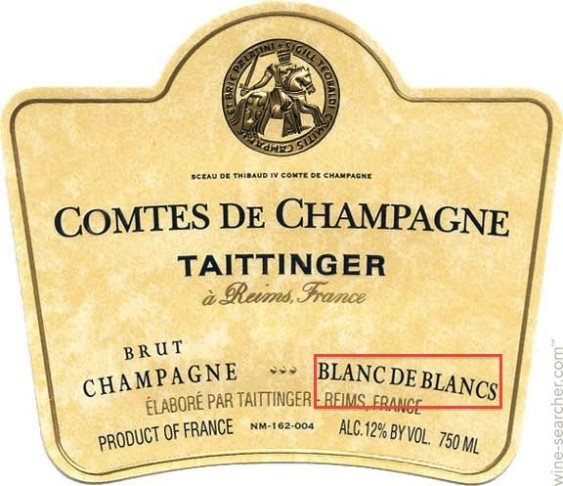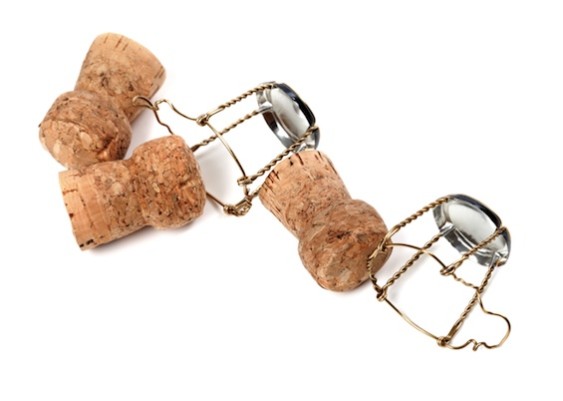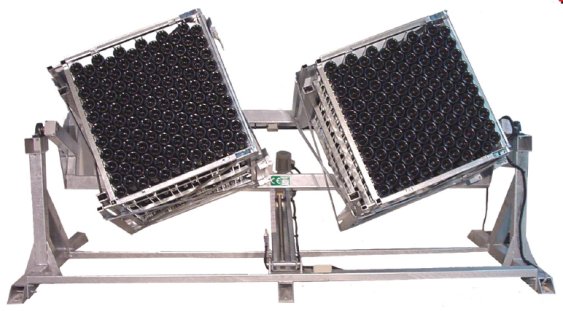As you know by now, December is Champagne Month on Cluster Crush. So far, we’ve covered the sweetness scale in champagnes, what riddling tables are for, and how you can keep your champagne bubbly after you open it. Today, it’s time to decode a few of the more arcane terms associated with champagne and why you should know what they mean.

When a champagne is labeled “blanc de blancs,” it means that it’s made from Chardonnay.
Blanc de blancs: Champagne is generally made from a combination of three grape varieties: Chardonnay, Pinot Noir and Pinot Meunier. However, not every champagne has all three, and any that are designated blanc de blancs, or “white from whites,” are made just from Chardonnay. Chardonnay lends a blend a lovely acidity, liveliness and the ability to age, so look for those characteristics in spades with a blanc de blancs.
Blanc de noirs: Champagne that is made from one or both of the other two varieties, Pinot Noir and Pinot Meunier. It means “white from darks,” and refers to the fact that both Pinot Noir and Pinot Meunier are red grapes. Pinot Noir is responsible for the overarching structure to a champagne, while Pinot Meunier tends to be fruitier and little more lively up front.

Ever wonder what those little wire things on the cork are called? Find out below!
Cuvée: This means “blend” or “batch” in French, and is used to refer to a wine that has been blended from various grapes or selected barrels or vats. In terms of champagne specifically, it can also mean the best juice derived from the first, gentlest pressing of the grapes.
Disgorgement/Dégorgement: Remember when I explained how champagne gets its bubbles? To induce secondary fermentation within individual champagne bottles, winemakers add a bit of sugary liquid and yeast (called the liqueur tirage) then cap the bottle with a metal lid. After aging and riddling, the leftover solids, or lees, accumulate in the neck of the bottle. Then when it’s time to cork the bottle and send it off into the world, champagne-makers must flash-freeze the neck of the bottle so the lees solidify into a kind of plug. The metal lid is popped off the bottle and that plug shoots out of the bottle, thus, being disgorged.
Dosage: This is an amount of sugar that’s added to the champagne after disgorgement in order to balance out the wine’s inherent acidity and to standardize the taste to the house style of wine. The liquid used is called the liqueur d’expédition, and is usually made from a combination of cane sugar and wine.

Gyropalettes are used instead of traditional riddling tables these days. Photo courtesy of Nuance.
Gyropalette: These are big machines that automatically riddle large batches of champagne bottles at the same time. They can hold up to 500 bottles and thanks to being able to work 24 hours a day, can complete the riddling process in about a week, compared to six weeks if doing it by hand.
Millésime: This term means “vintage” and is used for champagnes made from the wine of a specific year. Whereas the vast majority of champagne these days is labeled N.V. for “non-vintage,” if a champagne house believes that a certain harvest is going to result in a wine of outstanding quality, it might hold some of that wine back to produce a vintage champagne from that year. In order even to consider making a millésime champagne, the year must be declared a vintage year such at harvest, not after the fact.
Muselet: Derived from the French word for “muzzle,” this term refers to that delicate metal-wire cage that fastens the champagne cork to the bottle. The plaque de muselet is that thin metal disk anchored to the top of the cork that usually displays the logo or heraldry of the champagne house. The muselet is there as a safeguard to keep the cork in place despite growing or changing pressure within the bottle.

Remuage, or riddling, is performed to remove the yeast sediment from bottles of champagne.
Remuage/Riddling: This fanciful term denotes the act of gently twisting champagne bottles after they have undergone secondary fermentation in order to accumulate the leftover yeast particles, or lees, in the neck of the bottle so that they can easily be removed before adding the dosage and corking the bottle.
Tirage: This term just means bottling. As I mentioned above, there is a liqueur tirage, which is a combination of sugary liquid and yeast meant to induce secondary fermentation (the one that produces carbon dioxide and hence all those delicious bubbles) in the bottle. It’s called that because it is put into the wine at the time of bottling.
Have any other questions about champagne? Tweet me @clustercrush!

